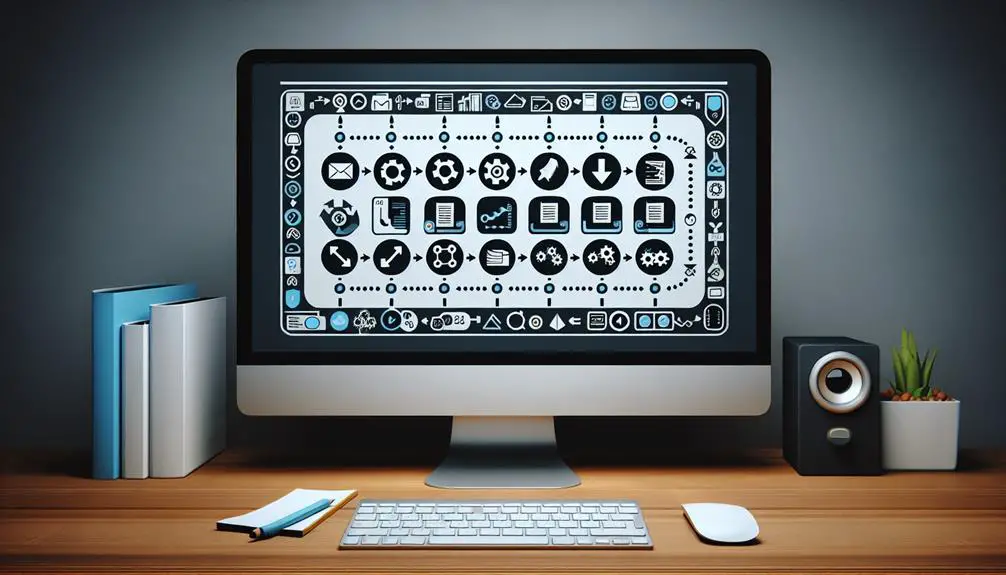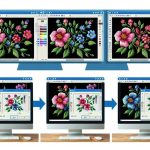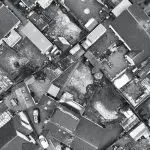Imagine this – you've just designed a beautiful custom logo for your friend's embroidery business, but now they need it in a PES file format to work with their machine.
Ever wondered how to make that conversion smoothly? Well, let me share some insights on how to seamlessly switch your design to a PES file format and get those embroidery machines whirring in no time.
Table of Contents
Key Takeaways
- Select the right software for precise design conversion.
- Ensure design compatibility and size match for smooth conversion.
- Optimize and customize designs before converting to PES format.
- Master export settings to guarantee successful PES file conversion.
Understanding PES File Format
When I first started exploring the world of embroidery, understanding the PES file format was like uncovering the key to a treasure chest. It's the magical code that allows your embroidery machine to recreate intricate designs with precision.
One important aspect to take into account when working with PES files is stitch density analysis. This analysis helps make sure that the design will stitch out correctly without any gaps or overcrowding of stitches. By examining the stitch density, you can make adjustments to achieve the perfect balance for your design.
Another essential element in PES files is color palette selection. The color palette determines the shades used in your embroidery design. When selecting colors, it's important to take into account factors like the type of fabric you're using and the overall look you want to achieve. A well-chosen color palette can enhance the beauty and impact of your embroidery project.
Mastering these aspects of the PES file format will elevate your embroidery skills to new heights.
Choosing the Right Software
As I explore the world of embroidery, selecting the right software becomes a key decision in bringing my designs to life with precision and creativity. When choosing embroidery software, it's crucial to conduct a thorough software comparison and features analysis. Look for programs that offer a user-friendly interface and tools that align with your design needs. Consider the learning curve of each software; some are more intuitive, while others may require additional time to master.
Embroidery software varies in capabilities, from basic design functions to advanced editing features like intricate stitch settings and lettering options. Take into account your current skill level and future aspirations when evaluating the software's offerings. Some programs excel in digitizing capabilities, allowing you to transform images into stitch patterns effortlessly. Others focus on providing a vast library of pre-designed motifs for customization. By understanding your requirements and preferences, you can make an informed decision that suits your embroidery goals.
Importing Your Design
Let's explore how to import your design seamlessly into the embroidery software you've chosen.
- Design Import Troubleshooting: Make sure your design file is in a compatible format with your software.
- Stitch Out Quality Analysis: Preview how your design will stitch out to catch any potential issues early on.
- Check Design Size: Verify that the dimensions of your design match the hoop size to avoid cropping or distortion during embroidery.
When importing your design, it's important to troubleshoot any issues that may arise. Check for file compatibility and make necessary adjustments to guarantee a smooth import process.
Additionally, take the time to analyze the stitch-out quality of your design. Previewing the embroidery sequence can help you identify and rectify any potential problems before they affect the final result.
Adjusting Design Parameters
To enhance the design, adjust the parameters as needed for best results. Design customization allows for personal touches, like changing stitch density to achieve different textures or effects.
If you want your design to really pop, consider tweaking the colors to match your vision. Vibrant hues can make a design stand out, while subtle tones can create a more delicate look.
Don't forget about resizing dimensions. Sometimes a design needs to be bigger or smaller to fit perfectly on your project. Just remember that resizing too much can affect the overall quality, so make adjustments carefully.
Saving Your PES File
So, when it comes to saving your PES file, it's important to know about the different file format options available.
I'll guide you through the export settings that can help you get the best results for your embroidery designs.
Let's make sure your creative work is saved and ready to be used in the most efficient way possible.
File Format Options
When saving your PES file, consider the different file format options available to guarantee compatibility with your embroidery machine. Here are some tips to help you choose the right format:
- File format comparison: Understand the differences between popular embroidery file formats like PES, DST, and EXP to select the most suitable one for your machine.
- Conversion: Explore tools or software that can convert your design into the PES format if it's not the native format of your design.
- Design customization, optimization: Customize and optimize your design before saving it as a PES file to ensure a flawless embroidery outcome.
Choosing the correct file format is important for a seamless embroidery process.
Export Settings Guide
For crafting enthusiasts looking to save their designs in the PES file format, understanding the essential export settings is important for a successful embroidery project. When exporting embroidery designs, pay attention to details like stitch density, color matching, and hoop size compatibility. These settings can make a significant difference in the final stitched outcome. Here's a quick guide to help you navigate through the export settings:
| Export Setting | Description |
|---|---|
| Stitch Density | Adjusts the number of stitches per inch for the design. |
| Color Matching | Ensures accurate color reproduction in the embroidery. |
| Hoop Size Compatibility | Selects the appropriate hoop dimensions for the design. |
Mastering these file format conversion techniques will elevate your embroidery game and result in beautifully crafted projects.
Transferring to Embroidery Machine
Alright, let's talk about transferring your PES file to your embroidery machine.
First, we need to make sure the software is compatible with your machine.
Then, we'll go through the process of converting the file format and setting up the connection to your embroidery machine.
Let's get those designs stitching!
Software Compatibility Check
Curiously, is our software compatible for transferring designs to the embroidery machine? When it comes to software compatibility for embroidery machines, a few things are important to contemplate:
- Check File Types: Confirm the software supports the required file formats for your embroidery machine.
- System Requirements: Verify that your computer meets the necessary specifications to run the embroidery software smoothly.
- Machine Communication: Test the connection between your computer and the embroidery machine to avoid any communication breakdowns during the transfer process.
Making sure your software is compatible can save you time and frustration down the line.
File Format Conversion Process
When converting files to be transferred to an embroidery machine, it's essential to make sure the correct file format is used for seamless compatibility.
After making certain the design is in the right format, focus on color selection. Choose thread colors that best represent the design and bring it to life.
Additionally, consider stitch density to make sure the design is embroidered correctly. Stitch density refers to the number of stitches in a specific area and impacts the final look of the embroidery.
Balancing color selection and stitch density is important for achieving a high-quality embroidered design. These factors play a significant role in how the design will turn out once it's stitched onto the fabric.
Machine Connection Setup
Let's now set up the connection to the embroidery machine to transfer the design.
- Check the machine's manual for specific instructions on connecting to a computer.
- Make sure the machine is turned off before connecting the USB cable.
- Test the connection by transferring a simple design to confirm it's working.
When dealing with machine connection setup, it's important to follow the manufacturer's guidelines to avoid any troubleshooting machine errors. Regular machine maintenance can also help prevent issues, ensuring smooth transfers. Understanding machine embroidery techniques like adjusting thread tension can further enhance the quality of your designs.
Mastering these basics will help streamline the process from digital design to embroidered reality.
Testing Your Stitch-out
To guarantee the quality of your embroidery design, it's important to test your stitch-out before proceeding further. Testing your stitch-out ensures that your design will come out exactly as you envisioned it. One key aspect to focus on during this process is stitch-out quality. By examining the stitch-out closely, you can identify any areas that may need adjustments to enhance the overall look of your design.
Another important element to assess during the testing phase is color accuracy. Ensuring that the colors in your design match your expectations is essential for achieving the desired outcome. By testing the stitch-out, you can make any necessary color corrections before embroidering the final piece.
Frequently Asked Questions
Can I Convert a PES File to a Different Embroidery File Format?
Yes, I can convert a PES file to another embroidery format; however, limitations exist due to file structures. Check compatibility with the desired format. If conversion isn't feasible, consider using alternative methods like software or online converters.
How Do I Troubleshoot if My PES File Is Not Importing Correctly Into My Embroidery Software?
Having trouble importing PES files into my embroidery software? Let's troubleshoot together! Check software compatibility, validate proper file conversion. Common issues like corrupted files or outdated software may be causing the problem.
Are There Any Specific Settings or Preferences I Should Be Aware of When Saving My PES File?
When saving a PES file, it's essential to contemplate file compatibility and specific saving options. Ensuring the right settings are chosen can prevent issues when importing into embroidery software. It's all about being meticulous!
Can I Preview My Design Before Transferring It to My Embroidery Machine?
I can preview my design using embroidery software to make sure it looks correct before stitching. Compatibility with my software is key. This helps me catch any issues early, preventing stitch-out troubleshooting and machine errors.
What Should I Do if My Stitch-Out Results in Errors or Mistakes?
If my stitch-out results in errors or mistakes, I troubleshoot by checking thread tension, needle type, design integrity, and stabilizer use. Making adjustments and rethreading can often resolve issues, ensuring a successful embroidery outcome.
- The Perfect Fit: How Tight Should Selvedge Denim Be When You Buy It? - June 24, 2025
- How to Fade Selvedge Denim for High-Contrast Whiskers and Honeycombs - June 24, 2025
- How to Stop Indigo Bleed From Your New Selvedge Jeans - June 24, 2025







